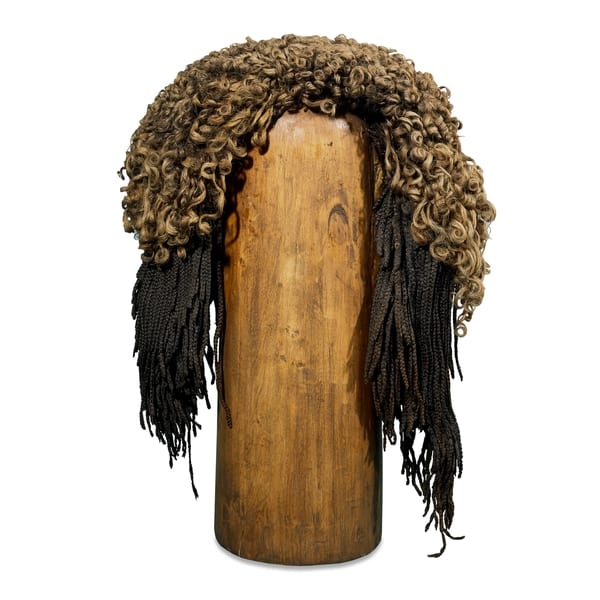Was Helen of Troy a Natural Blonde?
By Gemma Angel, on 6 May 2013
 by Tzu-i Liao
by Tzu-i Liao
Petrie Museum holds an extraordinary sample of pale yellow human hair, which is attached to a patch of scalp and entangled with darker curls that are most likely hair from a wig. It is very tempting to assume that the wig was used to conceal – even in the afterlife – the natural blonde hair colour of the wearer. On discovering this artefact in a tomb at Gurob, Petrie himself wrote that “the person was light-haired and wore a wig of black, hiding the foreign token.” Petrie based his argument on traditional studies of the ancient Mediterranean world. It is very likely that the vast majority of ancient Egyptians probably did have darker, coarser hair, and blonde hair in this context would have been very unusual. The use of wigs was not an uncommon practice amongst the ancient Egyptians, as many Egyptologists of Petrie’s era recognised. Indeed, bodily features were definitely a strong point of reference in recognising foreigners, and having different hair colour was surely one of them. Consider, for example, the common epithets (nick-names) for different ethnic groups used in ancient Greek literature: the hairy-headed Achaeans (kare komoontes), Abantes (Thracians), known for their long hair (opithen komoontes), and the bright-haired (likely golden, or blonde) Menelaus (xanthos) – including Helen of Troy (described as having bostrychous xanthes komes).
The example of Helen is particularly interesting for our discussion, not only because she might have been blonde, like the owner of the black wig in Petrie Museum, but also because she may have been to ancient Egypt as well. In Euripides’ tragedy Helen, the beautiful wife of Menelaus was not abducted to Troy; instead, she was sent by a god to Egypt to avoid this terrible fate. If Petrie’s theory about the purpose of the black wig was correct, Helen, as a refugee with conspicuous blonde hair, would probably have tried to ‘hide her foreign token’ with a similar black wig.
While this all sounds very intriguing to a classicist like me, there is no textual or archaeological evidence which can confirm the theory that wigs were used to conceal particular hair types denoting unfavourable ethnic features. On the contrary, as the hairstyles represented in Egyptian art are often described by Egyptologists as wigs, it appears that wigs of this kind were more likely worn more commonly for other aesthetic reasons. Another wig from ancient Egypt (Thebes) in the British Museum is a good example of this counterargument. This piece consists of hair of two colours; a lighter shade arranged into looser curls on the top, and darker long braids underneath. The two colours are presented in different styles in one hairpiece, the lighter colour appearing more prominently over the darker hair. Having lighter hair colour does not seem to be too much of a concern here. The important thing is to have the style on display – or even, to distinguish the special status of the wearer. It is less likely that our blonde woman wore the black wig to make herself look just like everyone else. This wig was probably worn on special occasions, or to denote her high social status. J. Stevens Cox even suggests that the prevalent use of wigs as fashion and status markers in the Roman empire was in fact a result of contact with Egypt, where it was already a popular practice.[1]
The reason that Petrie so quickly assumed that the black wig was worn for purposes of concealment of ethnic identity, probably owes more to his interest in eugenics. Since the time of Aristotle, many people have made often spurious connections between appearance and character. In the era of eugenics, bodily features supposedly denoting psychological or moral character were not only categorised but also ranked in a hierarchy. Petrie’s interest in these theories are apparent in his archaeological work as well as in his writing; he extensively documented Egyptian monuments that displayed “racial types”; he collected glass and terracotta figurines or heads that depict ethnic phenotypes and labeled them somewhat arbitrarily (a selection of these are presented in our recent Foreign Bodies exhibition). As late as 1934, Petrie sent skulls of “racial types” to Francis Galton, the father of eugenics, for further research.[2] In the preface of his Janus in Modern Life [3], Petrie clarifies the purpose of such studies, describing them as “physiological research of the obscure causes of [present] troubles” (to use a medical metaphor), since “the present time seems to most people so infinitely more important…than the past or future,” and “[t]hey forget that it is only a fiction to speak of the present…and every such present has been entirely conditioned by its past…” Looking at his work retrospectively, it is clear that much of his own reading of the past was actually largely conditioned by his present. He made some of the very mistakes he set out to help the world to avoid.
References:
[1] J. Stevens Cox, “The construction of an Ancient Egyptian wig (c. 1400 B.C.) in the British Museum”, in Journal of Egyptian Archaeology Vol. 5 No. 63 (1977).
[3] W. M. F. Petrie, Janus of Modern Life. G.P. Putnams’ Sons (1907).
 Close
Close


